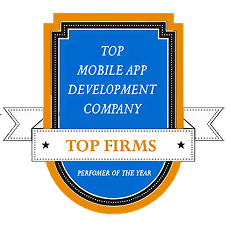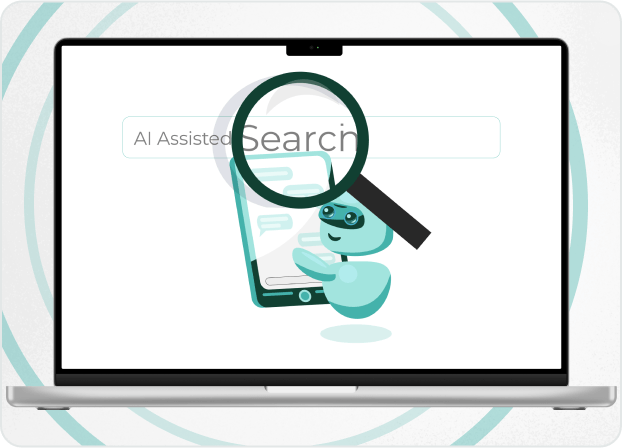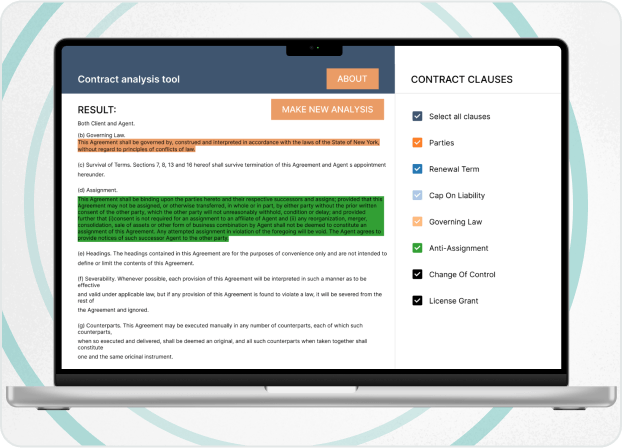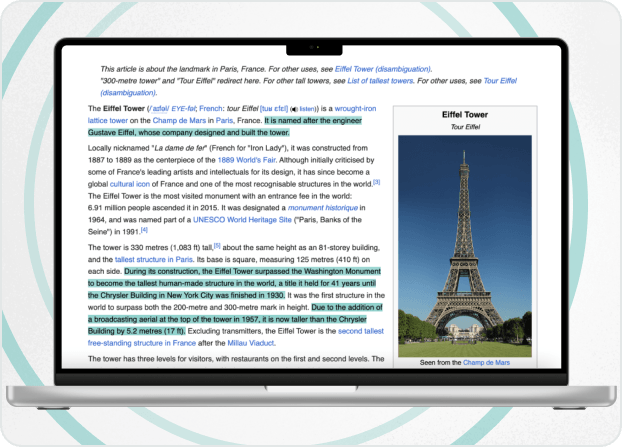
Author’s Thoughts

"The topic of LLM comparison has erased a vast space of discussion for the past years and each LLM provider tries to present their solution as the most explicit, accurate and versatile.
Silk Data as a company with a comprehensive expertise in AI solutions and LLM integrations have always appreciated critical approach, so the following blogpost represents not an LLM leaderboard but our vision of the most popular LLMs capabilities."
Yuri Svirid, PhD. — CEO Silk Data
LLM Industry Overview
On November 30, 2022, Open AI released its ChatGPT product – a chatbot with a generative AI feature which provides natural language human-like responses to user queries.
ChatGPT immediately attracted larger audiences providing a vast range of abilities, such as coding, translating and text analysis and summarization based on deep contextual and semantic analysis.
For example, one of the latest news reports provided by News Bureau and Digital Future Center of Elon University indicates that more than half of the US adults use ChatGPT-like LLMs on an everyday basis for various personal reasons.
In addition, the beginning of 2025 was marked by DeepSeek V3 release – an LLM chatbot that was meant to become a ‘ChatGPT killer’. Though both tools still exist and prosper, DeepSeek caused a vast space for discussion on which model is better. The discussion goes even further, as Google and Anthropic released new versions of their own LLMs – Gemini 2.5 and Claude 3.7 respectfully.
The following blogpost will present a comprehensive overview of the large language models and compare the most prominent representatives.
What is LLM and How does It Work?
LLM or large language model is an artificial intelligence program built on machine learning principles with the main purpose of recognizing, processing and generating human language.
The essence of LLM working lies in its machine learning basis.
Traditionally, LLM development implies feeding a program with large amounts of data. These data can be related to specific tasks (marketing reports, scientific articles for text summarization, etc.) or everything that touches human activity (human language foundational, structure and hierarchy of scientific field, etc.).
Note! Present most popular LLM models such as ChatGPT are considered as foundational models, i.e. models trained on such a huge amount of data that they can be applied across a wide range of use cases. We thoroughly discover the essence and benefits of foundational LLMs in our blogpost dedicated to ChatGPT.
Apart from machine learning, modern LLM relies on two other basic principles.
Deep learning describes the principle when models can learn the patterns and facts from the loaded data with minimum human interference.
At the same time, a specific type of neural network called transformer model uses self-attention technique to identify the sequence and patterns between data elements.
All the above-mentioned techniques and principles allow large language models to perceive tabular and textual data, process them and identify the context. Altogether, they form a basis for human language generation and comprehensive responses to user questions that modern LLMs can provide.
LLMs History Overview
Before comparing LLMs, we should have a quick look at how technology has evolved. Historically, the evolution of LLMs can be divided into three main stages:
- 1
Early Natural Language Processing Models
The main representatives are n-grams, in which 'n' stands for the number of words that the system can perceive at one time or in a certain time interval. Such systems had extremely limited capabilities in the context of understanding complex linguistic structures, as well as patterns and relations between text parts. - 2
Recurrent Neural Networks (RNNs)
A principle that emerged in the early 2010s, described earlier in the section on the development of chatbots using natural language processing. It is based on processing tokenized sequences and outputting the results of this processing. Models based on this principle improved performance and extended the capabilities of large language models, but they were still difficult to scale and apply to complex tasks requiring a broad understanding of the context. - 3
Models Based on the Transformer Architecture
These models are based on the technology that uses a mechanism that allows a language model to identify and realize the importance and place of each word in the context of the whole text (its relationship and hierarchy with other words, and its influence on them in the context of the whole sequence), regardless of its position in that text. The transformer architecture is a basis on which all the most popular modern LLM systems work, including GPT (Generative Pre-trained Transformers). - 4
Large multimodal models and foundational models
The last known level of LLM evolution that was brought to stage in the early 2020s. LMMs and foundational models are the most prominent representatives of the LLM industry that obtain unprecedented capabilities of dealing with various content types (for example, transforming text prompts into images).At the same time, most of the recent large language models can be applied across vast range of tasks and thematical fields, because of the large size of datasets they trained on. Furthermore, right now there are more and more cases when the LLM development is based on the RAG approach. It is defined by practice when the RAG mechanism searches through the Internet or external sources to add more context into the response for user query.
In addition, some specialized foundational models can provide the most outstanding context memory, and, in some cases, the size of context window can be ten-fold larger compared to traditional LLMs.
An overview of all the above-mentioned data provides a better understanding of how modern large language models came to their current condition. However, comparison of LLMs also requires detailed research of the most prominent industry representatives.
ChatGPT 4.5
On February 27,2025 Open AI released a new GPT-4.5 version of its model.
The comprehensive blogpost from the developers themselves notes the following improvements:
Improved ability to recognize patterns, find connections and generate content.
A more natural way of interaction.
Advanced capabilities in problem solving, writing and programming improvements.
Increased model’s safety thanks to a greater number of stress and safety tests.
GPT-4.5 uses a scaled combination of two development paradigms: unsupervised learning and reasoning.
The first paradigm focuses on improvements connected with patterns and context recognition and model’s ability to predict them.
The scaling paradigm focuses on dealing with logical tasks or tasks consisting of a long sequence of steps.
Furthermore, Open AI presents statistics on the results of Simple QA (which tests LLMs according to challenging questions answering capabilities) and user preferences, comparing Chat GPT-4,5 with previous versions.
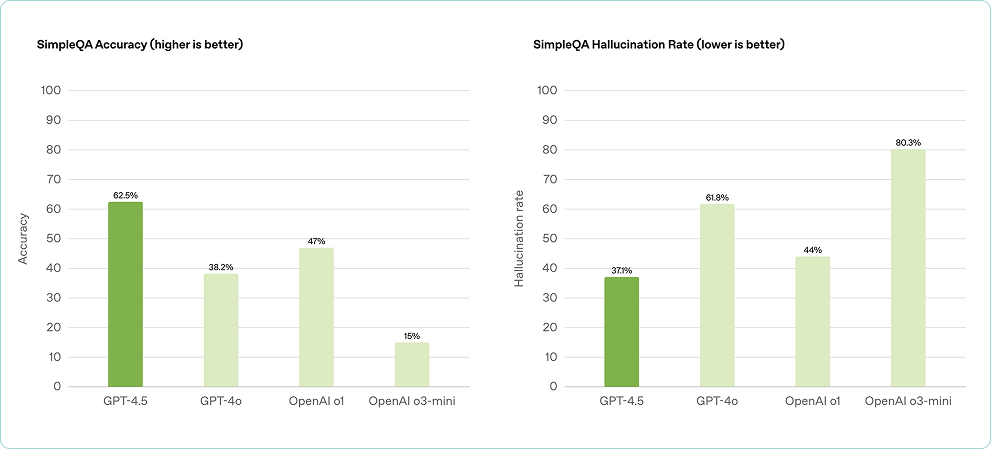
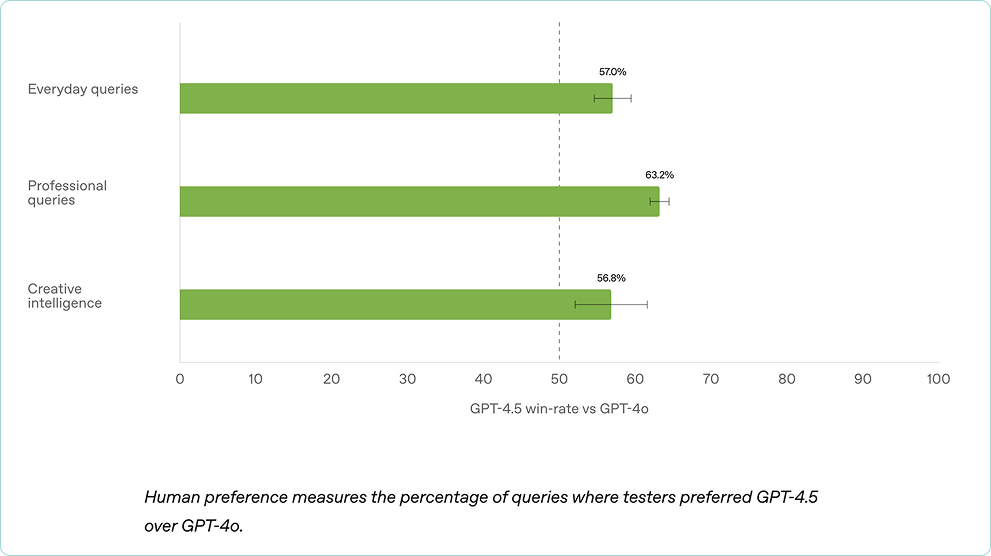
Source: https://openai.com/index/introducing-gpt-4-5
At the end, GPT-4.5 got through MMLU (Massive Multitask Language Understanding) LLM benchmark which consists of 16 thousand questions from 57 academic subjects and performs as the main tester of all modern LLMs. GPT-4.5 showed the results of 92% accuracy in responses in 15 most used languages including English, Spanish, French, Chinese and Arabic.
Despite successfully getting through initial testing and its promising results, ChatGPT demonstrates growing dissatisfaction of users. Customers report that previous version of the chatbot – ChatGPT 4o – lacks deep thinking capabilities, and ethical issues prevent it from solving some specific tasks (for example, planning a book plot line with a bad ending, as it always tries to finish the story in a good way). Moreover, some users point out that the time of request processing and answer generating was reduced to such a low rate that the users simply can’t trust the results.
However, ChatGPT is still considered a good tool for brainstorming and idea generation which appears to be useful for content creators and IT developers, while Open AI declares that the latest GPT-4.5 version got rid of all the previous drawbacks.
The implementation capabilities of ChatGPT remain severe and the model can be integrated into your digital products via OpenAI API. We tell more about certain advantages and considerations of ChatGPT API implementation in our articles regarding ChatGPT impact on the AI industry and ChatGPT usage for business.
Gemini 2.5
Next explicit representative of LLM industry is Gemini and its latest Gemini 2.5 version released on March 25, 2025.
Gemini series was launched in 2023 as a competitive response to ChatGPT popularity. There have been several versions released for the past two years, and Google declares that Gemini 2.5 is the most intelligent AI model ever created by the company.
The model has already been through a variety of tests, containing dozens of performance metrics, and Google demonstrates the results in a comprehensive table, comparing it to other popular models, including ChatGPT-4.5, Claude 3.7 and DeepSeek.
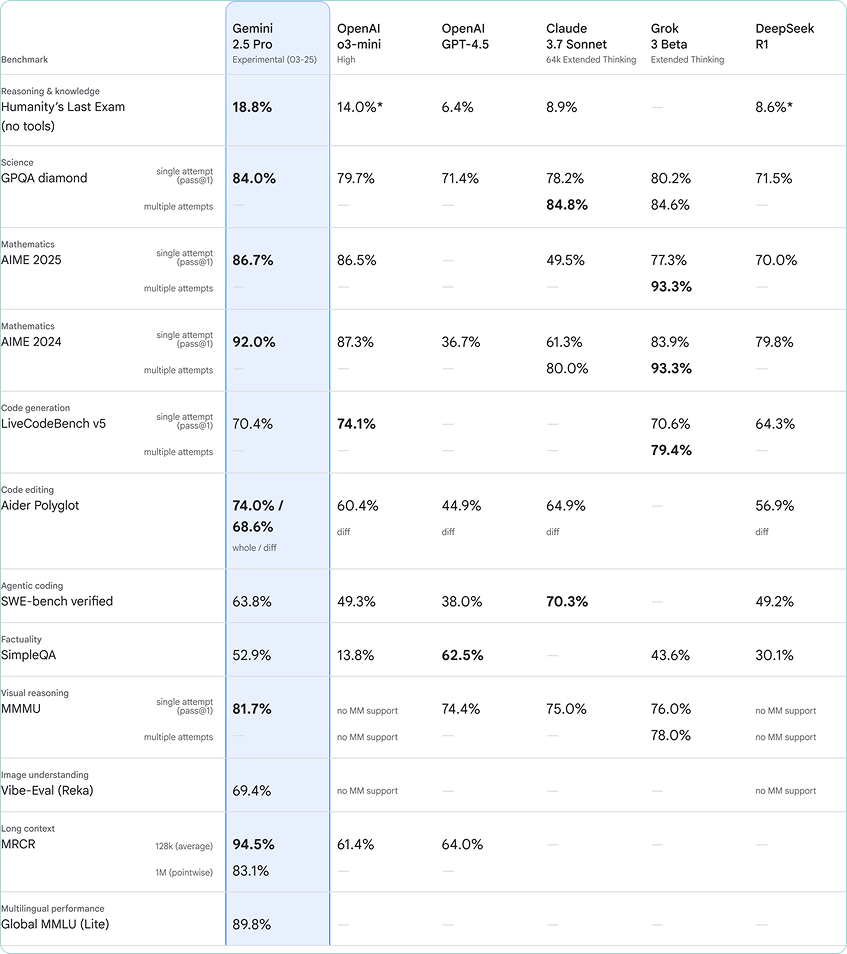
The market reports prove that Gemini achieved sufficient results for a very short period (primarily, thanks to the vast resources that Google can spend on AI development). The main market advantage of Gemini 2.5 is that the AI model and all its capabilities are available for all users without subscription, while ChatGPT-4.5 requires Plus subscription to access it.
For those who want to implement Gemini 2.5 into their workflows or applications, a special Gemini API is available. However, at the moment of the end of March 2025, the model is still experimental, and Google warns the users of that fact. We believe that all the limitations will be fixed in the near future.
Claude 3.7 Sonnet
The next model is Claude 3.7 Sonnet released by Anthropic company on February 24, 2025.
The model also uses a reasoning paradigm but in a unique way, as reasoning ability differs according to the mode the user chooses.
The standard mode is an upgraded version of the previous Claude 3.5 model which needs a little time for query processing. Extended thinking mode is more time-consuming (though the difference is mere seconds) but is far better in self-reflection and in solving tasks regarding math, physics and coding.
Furthermore, those who use Claude API can control the price of thinking. As Anthropic product charges 15$ for million output tokens, users can prompt the number of tokens required for answering the query. The output limit reached 128 thousand tokens (twice more than Gemini 2.5) making Claude 3.7 perfect for solving the tasks of high volume.
Anthropic declares that they shifted the model training focus towards real-world tasks, as they try to reach the rates and model situations of real business usage. Advanced reasoning and processing capabilities allow Claude to demonstrate sufficient results in many use cases such as:
Coding. It’s capable of completing tasks of the entire lifecycle – from initial planning and simple code generation to bug fixing and fine-tuning.
Data analytics. The model is able to extract data from visuals, such as diagrams or graphs.
Content creation and analysis. Advanced capabilities of understanding context and semantics allow Claude to reach the deepest levels of content analysis and patterns comprehension, so writing remains one of the most popular use cases.
It is worth noticing that if you have already been using Claude API in your products, you’ll have no trouble in dealing with Claude 3.7 Sonnet, as Anthropic granted access to all its API users.
DeepSeek V3
DeepSeek and its latest version, DeepSeek V3 presented on December 2024, is the last LLM considered in our blogpost but still the most controversial.
When the model appeared, the global market predicted it to be the most dangerous competitor of ChatGPT. The prediction primarily focuses on the fact that the DeepSeek’s development cost is an order of magnitude lower than the development costs of its competitors. Moreover, DeepSeek chatbot is available for anyone from everywhere and at any time – there are no geographic, software or subscription limitations in its usage.
DeepSeek team also declares that the model was trained on 14.8 trillion diverse and high-quality tokens, followed by supervised fine-tuning and reinforcement learning stages to fully harness its capabilities.
However, though being a decent tool for tasks regarding summarization or topic/subject explanation DeepSeek (especially its free chatbot) still needs further refinement. AI users all around the globe believe that there’s still a long way to go, but everyone appreciates that the open type model can compete with giants of the market.
Regarding the model integration into real applications, the DeepSeek API uses an API format compatible with OpenAI. By modifying the configuration, users can apply to the OpenAI SDK or software compatible with the OpenAI API to access the DeepSeek API.
LLM Comparison
As we mentioned we do not intend to create a custom LLM leaderboard and provide undeniably accurate LLM ranking. We reviewed the information presented by above-mentioned models' developers and by specialists who use AI tools in their work and hobby every day. All the gathered data were summarized in the following table:
| Criteria | ChatGPT-4.5 | Gemini 2.5 | Claude 3.7 Sonnet | DeepSeek V3 |
|---|---|---|---|---|
| Benchmark Performance | - 92% on MMLU (57 subjects) - Improved Simple QA scores | - #1 on LMArena - 63.8% on SWE-Bench - 18.8% on Humanity's Last Exam | Strong in math/physics benchmarks | Decent but not a benchmark leader |
| Language Support | 15 languages | Multilingual (exact number unspecified) | Multilingual (exact number unspecified) | Multilingual (exact number unspecified) |
| Output size | 128k tokens | 65k tokens | 128k tokens | 128k tokens |
| Pricing/Access | Available for Plus users | Free for all users | Available through Claude Plans (Pro, Team, Enterprise) | Free for all users |
| Best Use Cases | - Brainstorming - Content creation - IT development | - Complex reasoning - Coding - Math/science tasks | - Coding - Data visualization - Content analysis | - Summarization - Topic explanation - Smart recommendations |
| Weaknesses | - Perceived lack of depth - Ethical restrictions - Speed and downtime concerns | Still new with limited real-world testing | Limitations according to the selected mode | - Needs refinement - Less sophisticated than competitors |
| Integration capabilities | Can be integrated via ChatGPT API | Can be reached via Gemini API, but has some limitations because the model is still experimental | Available for all Claude API users | Can be done via OpenAI SDK or software compatible with the OpenAI API |
Conclusions
The rapid evolution of large language models (LLMs) since ChatGPT’s groundbreaking debut in 2022 has transformed the AI landscape, with 2025 marking a new era of competition and specialization. As we’ve explored, each of today’s leading AI models — ChatGPT-4.5, Gemini 2.5, Claude 3.7 Sonnet, and DeepSeek V3 — brings unique strengths to the table, catering to diverse user needs and redefining what AI can achieve. Through that, no objective and fair AI comparison is possible, as well as finding the fastest, most efficient and cost effective model.
What’s clear is that no single LLM is universally "best" — the ideal choice depends on context. Developers might favor Claude for lifecycle coding, researchers could lean on Gemini for scientific rigor, and content creators may still prefer ChatGPT’s fluency. Meanwhile, DeepSeek’s rise proves that innovation can thrive outside tech giants, hinting at a more diverse future for AI.
Our Solutions
We work in various directions, providing a vast range of IT and AI services. Moreover, working on any task, we’re able to provide you with products of different complexity and elaboration, including proof of concept, minimum viable product, or full product development.



















